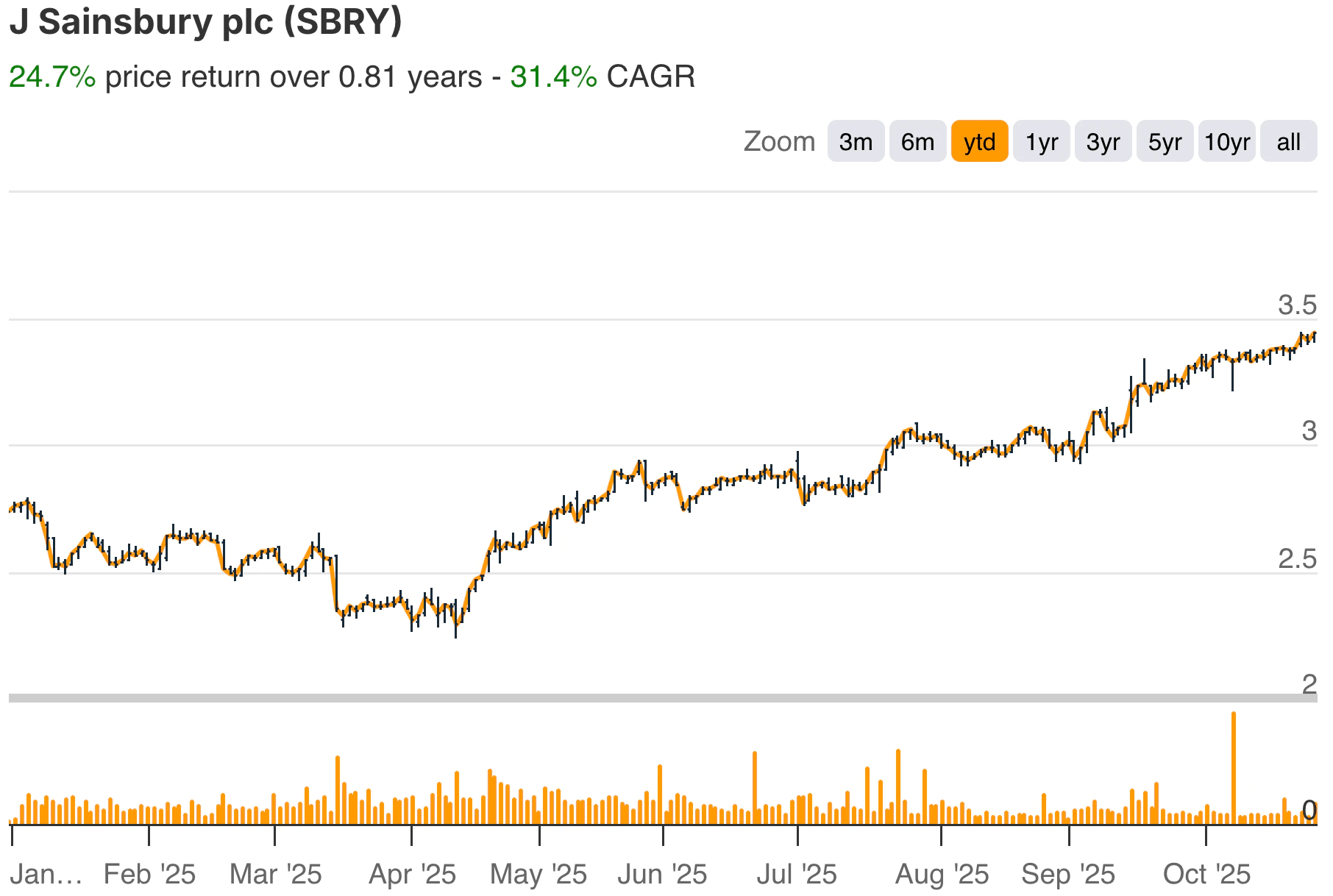J Sainsbury plc (SBRY) is the UK’s second-largest supermarket chain, operating more than 600 supermarkets and 800 convenience stores under the Sainsbury’s and Argos banners. With a history spanning over 150 years, the company has evolved into a multi-format retailer combining food, general merchandise, financial services, and digital operations. Its “Plan for Better” strategy continues to balance value, quality, and sustainability, positioning Sainsbury’s as a trusted national brand in the UK grocery market.
Find out what a stock’s really worth in under 60 seconds with TIKR’s new Valuation Model (It’s free)
For the year ended 1 March 2025, Sainsbury’s reported underlying pre-tax profit of £761 million, up 8.6% year-over-year and ahead of market forecasts. Retail sales excluding fuel rose 3.1%, driven by 4.5% growth in grocery volumes and strong performance in its Nectar loyalty and digital ecosystems. The grocer also announced a £200 million share buyback, a final dividend of 9.7 pence, and plans for a special dividend funded by the disposal of its banking unit.

The retailer’s return on capital employed climbed to 9.0%, and underlying EPS rose 4.5% to 23.1 pence, reflecting disciplined cost control despite investment in price reductions. Management guided for £1 billion in retail operating profit for fiscal 2026, a goal underpinned by its “Next Level Sainsbury’s” strategy to grow grocery volumes, strengthen digital channels, and simplify operations across Argos and general merchandise.
Track company financials, stock value, and competitor information with TIKR (It’s free) >>>
Financial Story
Sainsbury’s FY2025 performance underscored its progress in repositioning the business around its food leadership strategy. While inflation slowed, the company managed to protect margins by improving sourcing, optimizing logistics, and prioritizing own-brand innovation. Grocery volume growth of 4.5% marked a standout achievement in a flat UK retail market.
| Metric | Result | YoY Change | Commentary |
|---|---|---|---|
| Revenue | £32.81 B | +1.8% | Grocery up 4.5%; Argos down 2.7% |
| Underlying Pre-Tax Profit | £761 M | +8.6% | Above guidance and consensus |
| Retail Operating Profit | £1.04 B | +7.2% | Strong grocery offset Argos decline |
| Statutory Profit After Tax | £242 M | +76.6% | Favorable comparison to prior year |
| Underlying EPS | 23.1 p | +4.5% | Improved efficiency and mix |
| Free Cash Flow | £531 M | −17% | Lower due to higher investment |
| ROCE | 9.0% | +70 bps | Efficiency gains across supply chain |
| Dividend (FY25 total)** | 13.6 p | +4.6% | Progressive, sustainable payout |
Non-food sales, particularly from Argos, softened slightly due to a weak consumer electronics environment, but Sainsbury’s offset this with operational efficiency and strong customer retention. Group profit before tax outperformed expectations thanks to higher grocery volumes and a focus on value, the company invested £1 billion in price reductions over the past four years to strengthen its price perception versus competitors like Tesco and Aldi.
See Sainsbury’s full financial results & estimates (It’s free) >>>
Broader Market Context
UK supermarkets continue to operate in a hyper-competitive, low-margin environment shaped by discounters and changing shopping habits. The shift toward convenience and online grocery shopping remains structural, with Sainsbury’s digital and delivery network capturing a larger share of repeat customers. Its partnership with Deliveroo and enhanced Nectar360 loyalty analytics have provided additional leverage in retaining high-value households.
While inflationary pressures have begun to ease, consumer budgets remain tight. Sainsbury’s focus on lowering prices and improving value for money aligns with shopper sentiment, but it also puts pressure on short-term margins. The company’s response, investing in automation, renewable energy, and supply-chain efficiency, is designed to sustain profitability even as price competition intensifies.
1. Grocery Leadership Through Value and Volume
Sainsbury’s has decisively leaned into food retailing as its core competitive advantage. By doubling down on everyday value and consistent quality, the company regained grocery market share in 2025, reaching its highest share of primary shoppers in five years, according to Kantar data. The success of its “Aldi Price Match” and “Taste the Difference” lines helped attract and retain price-sensitive consumers while maintaining premium margins in select categories.
The retailer’s own-brand innovation pipeline has expanded across ready meals, bakery, and fresh produce, with more than 75% of new products labeled under its “Healthy and Better for You” platform. These efforts are complemented by Sainsbury’s ongoing rollout of smart-store technology and predictive inventory systems, which improve shelf availability and reduce waste. Together, these initiatives reinforce its position as a volume-driven, customer-centric grocery leader.
2. Streamlining Argos and Accelerating Digital Integration
Argos, while still a significant revenue contributor, continues to face headwinds in general merchandise demand. To address this, Sainsbury’s has shifted Argos toward a leaner, digitally integrated model, closing standalone stores and embedding concessions within supermarkets to cut costs and boost footfall. This strategy not only reduces overhead but also integrates online and offline channels more seamlessly for consumers.
Digital innovation remains a key growth pillar. Online grocery sales grew 12% year-on-year, and the company’s Nectar loyalty ecosystem reached over 18 million active members, enabling personalized promotions that improve conversion and retention. As Sainsbury’s refocuses capital on its digital platform, it’s achieving higher data monetization through Nectar360, driving incremental profit while deepening customer engagement.
Value stocks like Sainsbury in less than 60 seconds with TIKR (It’s free) >>>
3. Financial Resilience and Shareholder Returns
Sainsbury’s balance sheet has strengthened considerably over the past two years, supported by disciplined capital allocation and debt reduction. The company maintained a conservative leverage position while returning over £500 million to shareholders through dividends and buybacks in FY2025. The upcoming £200 million buyback and potential special dividend following the sale of its banking arm underscore management’s confidence in cash generation.
Free cash flow, though lower than the prior year, remains robust enough to fund reinvestment in automation, store refurbishments, and sustainability initiatives. The company’s 9% ROCE and rising cash returns indicate improving capital efficiency. Management’s guidance for £1 billion in retail operating profit for FY2026, alongside new store openings and stronger own-label margins, reinforces the trajectory of steady, disciplined growth with continued shareholder alignment.
The TIKR Takeaway

Sainsbury’s turnaround is entering its next phase, characterized by stronger grocery execution, operational simplification, and strategic focus. The company’s performance in FY2025 reflects successful navigation of inflationary headwinds and consumer trade-downs, while its investment in automation and digital capabilities sets the stage for longer-term margin expansion.
For investors, Sainsbury’s offers a compelling blend of stable income, improving profitability, and potential valuation upside as the company closes its discount gap with peers. Its forward-looking initiatives in sustainability, digital loyalty, and automation strengthen its competitive moat. However, persistent general-merchandise softness and thin UK retail margins mean growth will remain steady rather than spectacular.
Should You Buy, Sell, or Hold Sainsbury Stock in 2025?
After a 25% year-to-date rally, Sainsbury’s valuation still appears reasonable given its improving fundamentals and consistent cash generation. The grocer’s sharp operational focus, disciplined cost management, and shareholder returns policy make it one of the more balanced plays in UK retail. Investors looking for defensive exposure to consumer spending, underpinned by food-led resilience, should view Sainsbury’s as a quality long-term hold with moderate upside.
How Much Upside Does Sainsbury Stock Have From Here?
With TIKR’s new Valuation Model tool, you can estimate a stock’s potential share price in under a minute.
All it takes is three simple inputs:
- Revenue Growth
- Operating Margins
- Exit P/E Multiple
If you’re not sure what to enter, TIKR automatically fills in each input using analysts’ consensus estimates, giving you a quick, reliable starting point.
From there, TIKR calculates the potential share price and total returns under Bull, Base, and Bear scenarios so you can quickly see whether a stock looks undervalued or overvalued.
Estimate a company’s fair value instantly (Free with TIKR) >>>
Looking for New Opportunities?
- See what stocks billionaire investors are buying so you can follow the smart money.
- Analyze stocks in as little as 5 minutes with TIKR’s all-in-one, easy-to-use platform.
- The more rocks you overturn… the more opportunities you’ll uncover. Search 100K+ global stocks, global top investor holdings, and more with TIKR.
Disclaimer:
Please note that the articles on TIKR are not intended to serve as investment or financial advice from TIKR or our content team, nor are they recommendations to buy or sell any stocks. We create our content based on TIKR Terminal’s investment data and analysts’ estimates. Our analysis might not include recent company news or important updates. TIKR has no position in any stocks mentioned. Thank you for reading, and happy investing!








